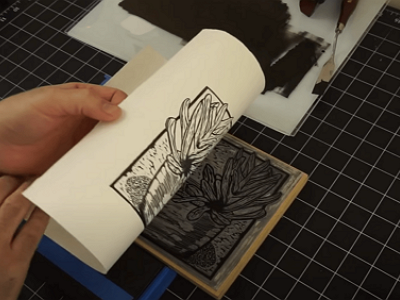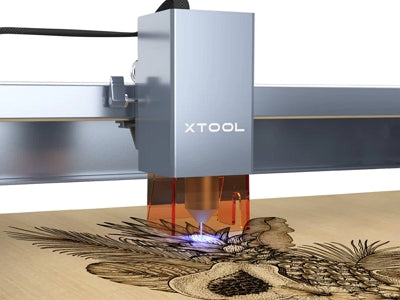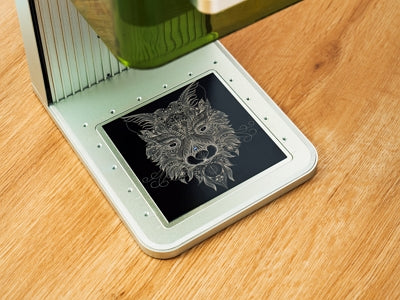Raster Engraving vs. Vector Engraving: What's the Difference
Raster engraving and vector engraving are the two types of engravings done using a laser engraving machine.
You might consider raster engraving in one case and vector engraving in another; it depends on the requirements. If you do the wrong type of engraving on a material, the result might not look good.
In this article, we will discuss raster engraving and vector engraving in detail. We will also share which engraving is better in different scenarios and how you can do these engravings on materials.
In This Article
- What is Raster Engraving?
- What is Vector Engraving?
- Raster Engraving vs. Vector Engraving: Which One to Choose?
- Best Laser Engraver for Vector and Raster Engraving
- Final Words
What is Raster Engraving?
Before diving into raster engraving, it is better to understand what a raster image is. After that, you will be able to understand how raster engraving works.
1) What is a Raster Image?
You might have zoomed in on images many times. When you zoom in on an image, you see small boxes or squares, which are called pixels. A raster image is made of tiny pixels, which is why it is also referred to as a pixel-dependent image.

When you use an inkjet printer, it also prints the image on a paper pixel by pixel. If you look closely at the print, you will realize that the printer has worked line by line. It prints all the dots in their original color. After completing all the dots, the image is completely printed.
There won’t be any space left on the image and all boxes will be connected with adjacent boxes to create the image.
The quality of the raster image depends on the number of pixels. The higher the pixels, the better the quality. But the increase in the number of pixels also increases the size of the image.
2) How Does Raster Engraving Work?
Raster engraving is done using a raster image or graphics. You can obtain such images from digital cameras. The common file formats that you see, such as JPG, PNG, TIFF, and BMP, are raster images. These are created with the help of pixels.
When raster engraving is done using a raster image, the laser engraver works line by line and point by point. It follows the same pattern of pixels and engraves the image over the object. The machine works like an inkjet printer. Due to the line-by-line operation of the machine, the engraving is quite bold and visible.
What is Vector Engraving?
1) What is a Vector Image?
A vector image on the other hand is a pixel-independent image. There are no pixels or square boxes even if you magnify the image. There are anchor points on the image, and these points are joined together with the help of a line or curve. It is quite similar to the Join the Dots activity that kids do at school. After joining the dots with lines and curves, you have an image.
In a vector image, only the outline or border is created through the fine lines and curves. The inner part of the image remains empty, unlike raster images. SVG, AI, and EPS are the common vector graphics formats.

2) How Does Raster Engraving Work?
When vector engraving is done with the help of a vector image, the laser machine connects the dot. If you are a mathematics student or have ever learned curves, you might know there is an equation for each curve.
For instance, there is an equation for a line, circle, parabola, sphere, and other figures. The laser machine uses such equations and makes the lines to join the anchor points.
Vector engraving has a similarity to laser cutting. In laser cutting, there are fine lines that are made along the boundaries to cut the materials. Similar fine lines are made in vector engraving, but the laser power is so low that it cannot cut the object; instead, it only engraves it.
In other words, if we lower the power settings in laser cutting, it will do vector engraving.
Raster Engraving vs. Vector Engraving: Which One to Choose?
If you want to choose images for engraving between raster and vector, you should know the appearance, limitations, and pros & cons of both.
We have discussed that a raster image is made of pixels. Thus, these images are resolution-dependent. Any change in the resolution will alter the image's appearance and quality. If you try to raster engrave a low-resolution image on a large object, the image quality will be the worst. You will see the squares or pixels.
In contrast, if you raster engrave a high-resolution image on a small object, the pixels will not have enough space to show up. It will mix various pixels and ruin the image. Thus, the size of the object should be according to the image.
On the other hand, vector images are pixel-independent. They are scalable to any extent, and it is why these are known as Scalable Vector Graphics (SVG). Therefore there is no limitation on the size of the object. Vector engraving can be done on any size of object, and there won’t be any compromise with the quality.
The second difference lies in the appearance of vector engraving and raster engraving. If you look at the raster engraving, it is bold and the engraving is clearly visible. When you touch raster engraving, you feel a 3D effect that is made by engraving each pixel on the object.
The pixels are engraved from corner to corner of the graphics, and there is no space left. If you don’t want to consider the minute details and need a 3D effect, raster engraving is perfect.
Vector engraving is smooth, and there are fine lines only. The thickness of the line is minimal. This type of engraving is ideal for fine details and artwork that requires fine lines.
Raster engraving is commonly used for:
- Photo plaques
- Honorary shields
- Medals
- Home decor items
- Tombstones
Vector engraving is commonly used for:
- 2D art and decor items
- Marking
- Logos and signatures
- Photos with fine details
Best Laser Engraver for Vector and Raster Engraving
For vector and raster engraving, you need a laser engraver that can support both types of graphics. It means that it should be compatible with raster image formats, such as JPG, PNG, JPEG, BMP, and TIFF, and vector graphics, such as SVG and DXF.
xTool D1 Pro is a high-accuracy diode laser engraver. It is an ideal machine for DIY projects, hobbyists, artists, professionals, designers, and small businesses. It supports both vector and raster engraving.
The machine is compatible with different file formats, including SVG, DXF, JPG, JPEG, PNG, BMP, TIF, CR2, and many more. Both vector graphics and raster formats are supported.
The most important thing about xTool D1 Pro is its high accuracy. The laser beams are confined at a very tiny sport measuring 0.08 x 0.08mm. It offers fine and clean lines while engraving. Due to its high accuracy, it is an ideal machine for raster and vector engraving.
Almost all laser engraving machines are capable of raster engraving, and they can offer good results. But the problem lies with vector engraving because it requires high accuracy movement of the laser module. If the machine is not capable of that, the vector engraving won’t give good results.
xTool D1 Pro has a high movement accuracy. First of all, the machine is made of a steel frame, which offers ultimate stability. Due to the sturdy structure, the repeat position accuracy is 0.02mm.
Secondly, the synchronous belt can be tightened as required. It offers high accuracy even at a very high speed. The steel shaft and wheels offer high movement accuracy of up to 0.01mm. Thus, the machine is perfect for vector engraving.
xTool D1 Pro is made for beginners, and it is quite easy to use. There are three diode modules available: 5W, 10W, and 20W. The 20W laser module is the world’s most powerful diode laser module.
The user can use the machine on a wide range of materials, including regular and irregular cylindrical objects. The 4-in-1 rotary attachment is available separately to engrave in 99% of the cylindrical engraving scenarios.
For raster and vector engraving, there is a complete table of power and speed settings for different types of materials. Users can easily look at the table and set their machines accordingly.
The specialized software of D1 Pro, xTool Creative Space, is user-friendly. It is easy to adjust the speed and power of the machine according to the requirements. Moreover, the machine can also run with LightBurn for professional tasks and more graphics formats.
Final Words
Raster engraving and vector engraving are both useful, but they are suitable for different purposes. Both have a distinct appearance, limitations, and pros & cons. We have discussed all these in detail to help users select the right engraving for their laser engraivng projects. Users can use xTool D1 Pro and do raster engraving and vector engraving with high precision.




